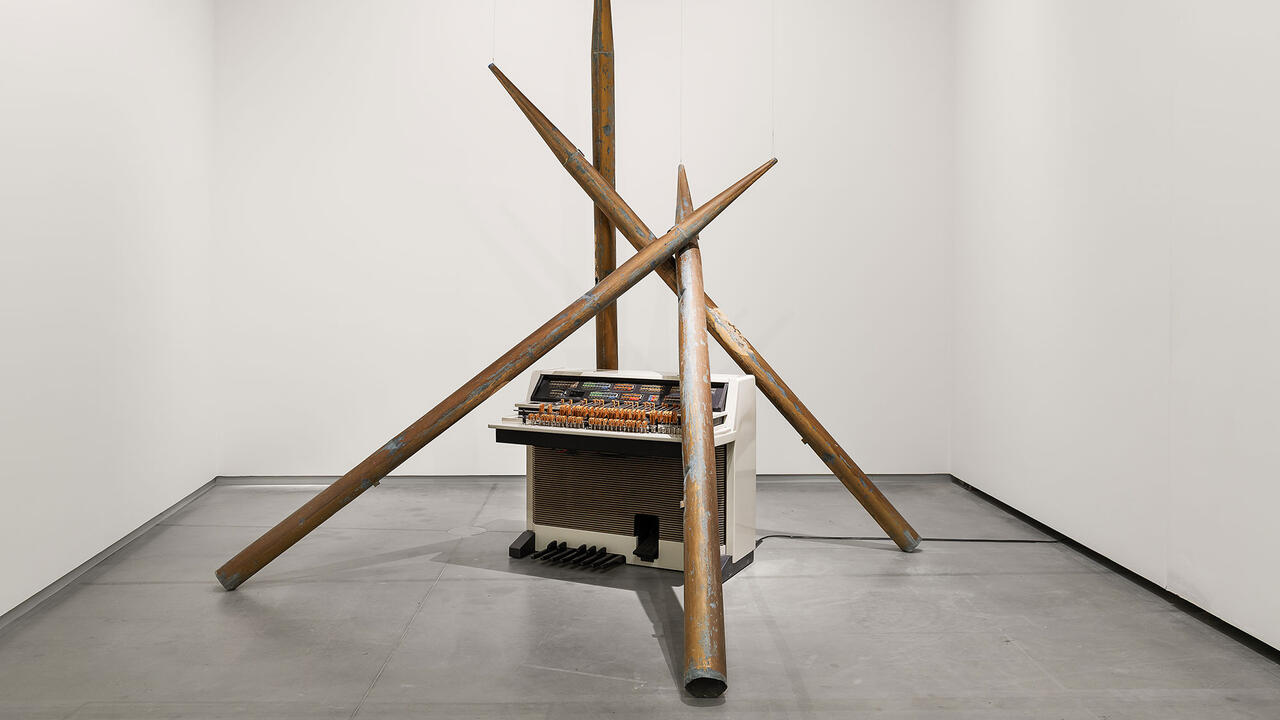A Show by the Late Lutz Bacher Evokes Something ‘Just Outside of Perception’s Grasp’
The last exhibition planned by the artist herself carries on her strategic semiotic slips and disjunctions
The last exhibition planned by the artist herself carries on her strategic semiotic slips and disjunctions

In his ‘Seminar on the Purloined Letter’ (1956), Jacques Lacan writes: ‘For it can literally be said that something is not in its place only of what can change places – that is, of the symbolic. For the real, whatever upheaval we subject it to, is always and in every case in its place.’
Lacan’s sentiment could describe Lutz Bacher’s art practice. Bacher spent 40 years making art that evoked something just out of perception’s grasp. ‘Blue Wave’ at the University of California Irvine (UCI) is Bacher’s final exhibition, conceived seven months before her death last May and curated by her longtime friend, artist and UCI professor Monica Majoli. Its four works (three new), all shown in separate spaces, reflect the artist’s recurring strategies: semiotic slips and disjunctions, chance and indeterminacy, gaps in meaning – signs that obliquely gesture to something other than themselves.

Blue Wave (2019), installed in the University Art Gallery, is a two-channel video focused on a billowing blue tarp hanging from a building in Manhattan’s Lower East Side. The videos were projected in two corners of the darkened gallery, accompanied by an amplified soundtrack of the street noise. According to the exhibition text, Bacher noticed the tarp, visible from her balcony, on 6 November 2018: the day of the US mid-term elections. For days after, she filmed it twisting in the wind. The movement of the camera shifts our attention between the tarp, its surrounding cityscape, the gallery architecture and the unseen artist; after a while, the fluttering material becomes hypnotic, assuming a near-ghostly form, seemingly inhaling and exhaling.

Blue Wave’s subtle allusions to America’s flailing democracy were thrown into relief vis-a-vis two pointedly political works, Rocket (2018) and Moskva (2019), in the nearby Contemporary Arts Center Gallery. The former (originally exhibited at SITE Santa Fe in 2018) is a 12-metre-long banner in the gallery lobby, depicting a US spacecraft laid out on a field and deconstructed into parts. For the latter work, Bacher cut and pasted dialogue from Russian spy novels and hung nearly 100 enlarged, unframed photocopies of these excerpts on the gallery walls. The text is comical in its conspiratorial and erotic melodrama, yet the spliced fragments recall the redactions and vagaries that obscure official government documents, like the Mueller Report into Russian interference during the 2016 US presidential elections. The Cold War symbolism in these two works demonstrates Bacher’s deep engagement with timely social and political subjects. What we might see as obsolete is, to her, raw material, ripe to regenerate in a new form: US President Donald Trump’s paranoid regurgitation of rhetoric from the era of President Ronald Reagan raises the question of whether the dismantled rocket may give rise to new, more menacing machinery.

A final work, the two-hour video Modules (2018–19), is screened in a utility room – opened upon request by an attendant – adjacent to the gallery in which Moskva is installed. Modules revels in the fluidity of presence and absence that characterizes much of Bacher’s oeuvre, in effect centring the artist by de-centring her. Screened on a monitor amid storage boxes and industrial equipment, the film cycles through the installation, waxing and waning crowds and de-installation of her past exhibitions. Bacher is present in shots of text exchanges on iPhone screens and fleeting glimpses, but she’s never palpably there. Although made before her unexpected death, Modules is a poignant elegy for an artist who worked under a pseudonym and was, herself, a kind of absent presence.

If Bacher’s spectral spirit lingers anywhere in ‘Blue Wave’, it is where certainty gives way to uncertainty, where we no longer see things – objects, ideologies – but, rather, an expanse of possibilities. Though invoking the bitter realities of American politics and life, the show verges on the poetic: a fitting farewell to an artist who forever chased the real.
Lutz Bacher, ‘Blue Wave’ is on view at University Art Gallery, University of California, Irvine, USA, through 14 December 2019.
Main image: Lutz Bacher, Rocket, 2018, installation view. Commissioned by SITE Santa Fe. Courtesy: the artist and Greene Naftali, New York; photograph: Jeff McLane






















